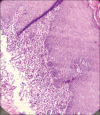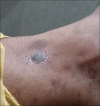Prevalence of oral lichen planus in patients with hypothyroidism versus non-hypothyroidism - A case control study of 1000 cases
- PMID: 37082069
- PMCID: PMC10112074
- DOI: 10.4103/jomfp.jomfp_517_20
Prevalence of oral lichen planus in patients with hypothyroidism versus non-hypothyroidism - A case control study of 1000 cases
Abstract
Background: The oral cavity is a unique environment where systemic maladies may be amplified by the oral mucosa. Oral diseases are usually local, but may also be the sign of systemic disease. Oral lesions are mostly one of the first indications of a systemic problem. Lichen planus (LP) is an inflammatory disease that involves the skin and mucous membrane. It is one of the most common oral diseases that manifest itself in the oral cavity. The exact cause of oral lichen planus (OLP) is unknown, but the immunologic system plays a leading role in the pathogenesis. It is well documented that OLP represents a cell-mediated immune response.
Materials and methods: The study population was drawn from the patients attending the outpatient Department of General Medicine and Department of Oral Medicine and Radiology with a total of 1000 subjects, out of which 500 subjects were clinically diagnosed with hypothyroidism and 500 subjects were without the history of hypothyroidism. The data collected was compiled and analysed to obtain the result. A Chi-square test was used to compare the categorical variables and the analysis was carried out on SPSS 16.0 version.
Results: The study revealed an increased prevalence of OLP in hypothyroidism. Cases clearly had a predilection of 2.37 times more tendency to develop OLP as compared to the control.
Conclusion: To conclude, it seems that OLP was more prevalent in hypothyroid individuals, especially in females in the third and fourth decades of life.
Keywords: Cutaneous lichen planus; hypothyroidism; levothyroxine; oral lichen planus; stress.
Copyright: © 2022 Journal of Oral and Maxillofacial Pathology.
Conflict of interest statement
There are no conflicts of interest.
Figures
















Similar articles
-
Crossroads between Skin and Endocrine Glands: The Interplay of Lichen Planus with Thyroid Anomalies.Biomedicines. 2023 Dec 28;12(1):77. doi: 10.3390/biomedicines12010077. Biomedicines. 2023. PMID: 38255184 Free PMC article. Review.
-
Prevalence of Oral Lichen Planus in Patients with Hypothyroidism Versus Nonhypothyroidism.J Pharm Bioallied Sci. 2024 Jul;16(Suppl 3):S2159-S2161. doi: 10.4103/jpbs.jpbs_111_24. Epub 2024 May 1. J Pharm Bioallied Sci. 2024. PMID: 39346485 Free PMC article.
-
Coexistence of thyroid disease and oral lichen planus in a Colombian population.Acta Odontol Latinoam. 2019 Aug 1;32(2):71-74. Acta Odontol Latinoam. 2019. PMID: 31664296 English.
-
Distinct Immunological Features Compared to Lichen Planus and Oral Lichen Planus.J Inflamm Res. 2025 Mar 18;18:4037-4056. doi: 10.2147/JIR.S506313. eCollection 2025. J Inflamm Res. 2025. PMID: 40125076 Free PMC article.
-
The microbiology of oral lichen planus: Is microbial infection the cause of oral lichen planus?Mol Oral Microbiol. 2018 Feb;33(1):22-28. doi: 10.1111/omi.12197. Epub 2017 Oct 9. Mol Oral Microbiol. 2018. PMID: 28869787 Review.
Cited by
-
Association Between Oral Lichen Planus and Thyroid Disease: A Cross-Sectional Study.J Clin Med. 2025 Apr 30;14(9):3106. doi: 10.3390/jcm14093106. J Clin Med. 2025. PMID: 40364138 Free PMC article.
References
-
- Carrozzo M. How common is oral lichen planus? Evid Based Dent. 2008;9:112–3. - PubMed
-
- Carrozzo M, Uboldi de Capei M, Dametto E, Fasano ME, Arduino P, Broccoletti R, et al. Tumor necrosis factor- A and interferon- g polymorphisms contribute to susceptibility to oral lichen planus. J Invest Dermatol. 2004;122:87–94. - PubMed
-
- Carbone M, Arduino PG, Carrozzo M, Gandolfo S, Argiolas MR, Bertolusso G, et al. Course of oral lichen planus: A retrospective study of 808 northern Italian patients. Oral Dis. 2009;15:235–43. - PubMed
-
- Cribier B, Frances C, Chosidow O. Treatment of lichen planus. An evidence- based medicine analysis of efficacy. Arch Dermatol. 1998;134:1521–30. - PubMed
LinkOut - more resources
Full Text Sources
Medical
